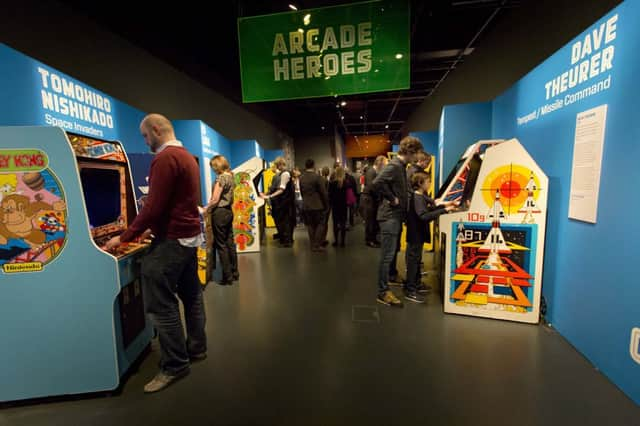Making a play for the gamer generation


The Game Masters exhibition at the National Museum of Scotland is nearing the end of its run. Since December, people have come in their thousands to enjoy over 100 playable games, from Pac Man and Space Invaders to Lemmings, Sonic the Hedgehog and Minecraft. And not only to play but to listen to the games developers and see the artwork and creativity that goes into creating some of the world’s most popular games.
There has been the unlikely spectacle of museum visitors young and old alike, singing along to Blur (on Singstar), dancing to Lady Gaga (Dance Central) or drumming and strumming along to Bon Jovi (Rock Band).
Advertisement
Hide AdAdvertisement
Hide AdThe museum is the first European venue for the exhibition, which was created by the Australian Centre for the Moving Image. It has been hugely popular, and has attracted many new visitors to the museum. One thing which has maybe surprised some people is the fact that they can come and experience an exhibition like this in a museum at all. Videogaming is not a new subject for National Museums Scotland. The Game On exhibition was staged here in 2002, and there are many consoles and home computers in our permanent collection. Gaming more generally is represented in the national collection much further back in time through counters, pieces and other archaeological and historical artefacts such as the Lewis Chessmen, an ornate silver and gold Renaissance draughts board and a copy of the 1920s board game David Livingstone Across Africa, among many others.
Where the historic material culture of our collections can tell us fascinating things about how our ancestors lived, so an exhibition on a contemporary topic like video games provides insights into today’s society and culture.
The hardware alone tells us a lot about how games have been played socially, from large, freestanding, coin-operated arcade cabinets through to home consoles and then handheld tablets and phones. Playing has changed from a solo pursuit into a group activity shared with family and friends. In the exhibition, there are moments where older visitors can explain how certain games work to their younger counterparts, and vice versa.
The evolution of games has been guided to some degree by the capabilities and physical form of the hardware and also by the gamers’ expectations as consumers. Alongside this there has been a change in the nature of gamers, with demographics shifting well away from old stereotypes; if indeed gaming ever was either a childish pursuit or a male preserve, it isn’t any more.
And then there are the people who make the games. Interviews with developers and designers throughout Game Masters offer insights to the creative processes, varied influences and the challenges of making games, and the many skills involved in creating a successful game.
Scotland’s notable contribution is reflected via some specific examples.
Dundee’s DMA Design was the first Scottish game developer to grab international attention, through titles like Lemmings and the early iterations of Grand Theft Auto, to become one of the biggest names in British gaming in the 1990s. Original artwork for Lemmings in the form of Gary Timmons’ pencil drawings, and the handwritten script for the original Grand Theft Auto, scribbled on an A4 notepad by Brian Baglow, show something of the remarkably modest starting points to these internationally significant gaming moments.
Dundee has continued to be a hub of game development for the UK through the programme of academic studies at the University of Abertay and its “Dare to be Digital” competition, to the host of current designers and developers based within the city. Throughout Scotland, young independent developers are flourishing, as the “Indies” section of the exhibition explores, with Dundee’s Space Budgie, Lucky Frame from Edinburgh and Glasgow’s Simon Meek.
Advertisement
Hide AdAdvertisement
Hide AdA series of supporting events is enabling the museum to explore these topical themes more closely, with events still to come on diversity and gender in gaming, on the adoption of gaming into everyday life and, on 15 April, “Made by Scotland, Played by the World” promises to highlight some of the successes and the challenges faced by game developers in Scotland.
So, on one level, it is all fun and games – over 100 of them, in fact. What presenting an exhibition like Game Masters in a museum context allows us and our visitors to do is take this engagement to the next level.
• Game Masters is at the National Museum of Scotland, Chambers Street, Edinburgh until 20 April.
Sarah Rothwell, Assistant Curator of Modern & Contemporary Design at National Museums Scotland.
SEE ALSO